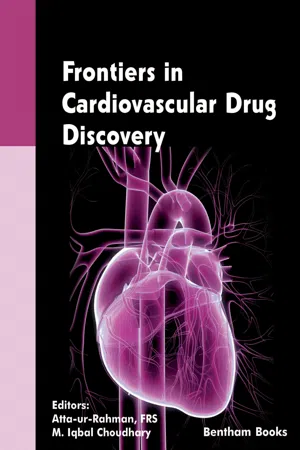Transient Receptor Potential Channels: Therapeutic Targets for Cardiometabolic Diseases?
Leidyanne Ferreira Gonçalves, Thereza Cristina Lonzetti Bargut, Caroline Fernandes-Santos* Instituto de Saude de Nova Friburgo, Universidade Federal Fluminense, Nova Friburgo, Rio de Janeiro, Brazil
Abstract
Transient receptor potential (TRP) channels are ubiquitously expressed cellular sensors that respond to changes in the cellular environment. They act in nociception, taste perception, thermosensation, mechanosensing, osmolarity sensing, and signal transduction. Mammalian TRP channels comprise 28 members divided into six subfamilies: TRPA (ankyrin), TRPC (canonical), TRPM (melastatin), TRPML (mucolipin), TRPP (polycystin) and TRPV (vanilloid). TRP mutations that result in either gain or loss of function have been linked to several human diseases, among them hypertension, cardiac hypertrophy, obesity, and diabetes. In the myocardium, TRP channels modulate Ca+2 handling and are differentially expressed in models of cardiac remodeling and dysfunction. TRP channels are also involved in insulin release from pancreatic beta-cells and glucose tolerance in rodent models of type 2 diabetes. Some of these channels promote thermogenesis and thus prevent diet-induced obesity. How TRP channels are modulated in vivo is still unknown since few endogenous ligands were identified so far. However, a wide range of natural products with therapeutic potential activates TRP channels and might serve as models for new drug discovery and development to prevent cardiometabolic morbidity and mortality. Studies with TRP channels show promising results, but the translation to preventive or therapeutic strategies against cardiometabolic diseases is challenging since they are found in multiple tissues and enrolled in several physiological actions, which increases the risk of adverse effects.
Keywords: Adipose tissue, Cardiovascular diseases, Cardiometabolic syndrome, Heart, Obesity, Pancreas, Type 2 diabetes, Transient receptor potential channels, TRPA1, TRPC, TRPM, TRPV.
* Corresponding author Caroline Fernandes-Santos: Instituto de Saude de Nova Friburgo, Universidade Federal Fluminense, Nova Friburgo, Rio de Janeiro, Brazil; Tel: +55 22 2528 7166; E-mail: [email protected] INTRODUCTION
Cardiometabolic syndrome (CMS), also known as insulin resistance syndrome,
syndrome X, Reaven’s syndrome, and Beer belly syndrome, is recognized as a disease [1] and has been defined in several different ways [2]. However, the consensus is that it is a combination of metabolic disorders, such as insulin resistance, impaired glucose tolerance, systemic arterial hypertension, central obesity, and atherogenic dyslipidemia [1, 3]. Around 25% of the adult population worldwide is reportedly suffering from CMS [4].
CMS is commonly associated with the development of cardiovascular diseases, and as obesity increases worldwide, it has become a global pandemic [3]. The western way of life, characterized by a sedentary lifestyle and the increased consumption of high caloric unhealthy foods, has created a positive energy balance environment, increasing the risk for CMS and cardiometabolic diseases [3]. CMS is a significant public health concern owing to the financial impact of higher hospitalization rates due to comorbidities; it also impacts physical well-being and the quality of life and reduces the workforce. Therefore, it is crucial to develop therapeutic strategies focusing on both CMS risk factors and treatment of comorbidities [3].
Transient Receptor Potential (TRP) channels have been identified as potential candidates for the treatment of many diseases, including the cardiometabolic ones, as over the last 15 years supporting evidence has emerged on their role in cardiovascular and metabolic functions. TRP channels are a group of non-selective ion channel sensors that responds to a broad spectrum of physical and chemical stimuli, playing a role in the physiological process of signal transmission [5]. They are primary targets for both endogenous and exogenous substances with therapeutic potential [6]. However, translation to preventive or therapeutic strategies remains challenging as they are present in multiple tissues and thus, are enrolled in several physiological pathways, increasing the risk of adverse effects [6].
Here, we discuss whether TRP channels present an opportunity to combat cardiometabolic diseases, which are a high cost to governments and affect patient’s well-being. Evidence shows that TRP channels are relevant as a therapeutic strategy, with additional research necessary to prove their safety and efficacy.
TRP CHANNELS
Cosens and Manning described the first TRP channel in a Drosophila melanogaster mutant [7]. From then, until 2017, 28 mammalian TRP channel proteins have been identified. The TRP superfamily of channels is categorized into six families based on amino acid homologies: ankyrin (TRPA), canonical (TRPC), melastatin (TRPM), mucolipin (TRPML), polycystin (TRPP), and vanilloid (TRPV) [5, 8]. The main structure of the TRP channel subunit has six transmembrane domains (TM1 to TM6) that are assembled as homo- or heterotetramers to form selective cation channels with diverse modes of activation and varied permeation properties [9]. They have distinct pharmacological properties, presenting a challenge in drug development [6, 10].
The TRPA family has only one protein identified (TRPA1). The TRPC family contains seven protein members (TRPC1-7), whereas the TRPM family includes eight members (TRPM1-8). The TRPML family contains three members (TRPML1-3), the TRPV family is comprised of six members (TRPV1-6), and the TRPP family has three proteins (TRPP1, TRPP2, and TRPP3) [5]. There is also a family called TRPN (NO-mechano-potential) found in worms, frogs, zebrafish, and Drosophila, with no homologous proteins in mammals [5]. TRP channels can be constitutively open or are activated by intracellular cations [5, 10]. While all TRP channels are permeable to cations, two TRP channels are impermeable to Ca2+ (TRPM4, TRPM5), and two others are highly Ca2+ permeable (TRPV5, TRPV6) [11].
TRP channels are found in the plasma membrane of distinct cell types, and cellular organelles such as ...
